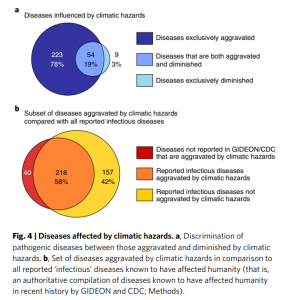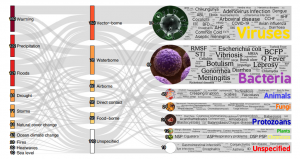
It is widely known that climate change is the biggest health threat to humanity, but more troubling information is being unearthed by researchers from across the world. A study by researchers from the University of Hawaii shows that more than half of the known pathogenic diseases can be aggravated by climatic changes caused by greenhouse gas emissions.
The study published in Nature Climate Change says global warming, changing rainfall patterns and extreme weather events are triggering the spread of diseases such as dengue, hepatitis, pneumonia, malaria, and zika by expanding the range of mosquitoes, ticks, fleas and other disease vectors.
The researchers led by Camilo Mora studied empirical examples of the impact of 10 climatic events — warming, drought, heatwaves, wildfires, extreme precipitation, floods, storms, sea level rise, ocean biogeochemical change, and land cover change — on human pathogenic diseases. They reviewed more than 70,000 scientific papers for empirical examples of climatic hazards impacting the diseases.
READ I Climate change: India sets tough emission targets for 2030
Diseases affected by climate change

Pathogenic diseases aggravated by climatic hazards

The study found that these climatic hazards influence diseases triggered by viruses, bacteria, animals, fungi, protozoa, plants and chromista. According to the findings of the study, around 58% of the 375 known pathogenic diseases are affected by at least one climatic hazard.
“It was truly scary to discover the massive health vulnerability resulting as a consequence of greenhouse gas emissions,” the University of Hawaii website quoted Camilo Mora, the lead author of the study. The number of diseases and the pathways of transmission will make it difficult for humans to adapt to climate change, he said. The research team comprised experts from various schools and departments of UH.
Climatic hazards affected by GHG emissions

Highlights and key findings of the study
Climatic hazards result in the expansion of vectors and pathogens by expanding the area and duration of the facilitating environment. Heat and rainfall changes expand the range of vectors like birds, mosquitoes, and fleas. The recent outbreaks of dengue, chikungunya, plague, Lyme disease, West Nile virus, Zika are blamed on mammals and birds.
Another way climate change causing outbreaks is by bringing people closer to pathogens. Storms, floods and sea level rise cause human displacements and migration, triggering outbreaks of lassa fever, giardiasis, gastroenteritis, cholera, pneumonia, typhoid, hepatitis, and respiratory diseases. Climate change also enhances climate suitability for reproduction of pathogens and accelerates their life cycle, resulting in an increase in the likely exposure and virulence.
Climate change also reduces human ability to cope with pathogens by changing body conditions. Droughts, for example, result in poor sanitation, leading to an increase in cases of trachoma, cholera, conjunctivitis, diarrheal diseases, dysentery, and typhoid fever.
While a majority of diseases were aggravated by climatic hazards, 63 others were diminished. Incidence of several viral diseases has fallen because extreme heat is unsuitable for viruses and immune systems are stronger in warmer conditions. Some of the diseases that were diminished by one hazard were aggravated by another.
The world has finally begun to take notice of the harmful effects of global warming on the environment and human life. The increasing incidence of extreme weather events such as cyclones, floods, droughts, heatwaves and rising sea level are threatening life in some of the thickly populated regions of the world. People have started feeling the impact of climate change in their own backyards, leading to increased awareness and calls for mitigation.
It is estimated that nearly three fourths of the extreme weather events are triggered or worsened by human-caused climate change. Several studies have shown that about 80% of all extreme climate events had some human impact. More than 90% of the extreme heat events are either caused or worsened by climate change. More than half of the rainfall or flooding events were caused by human-caused climate change. More than two thirds of the drought events also are caused by climate change.
Anil Nair is Founder and Editor, Policy Circle.

